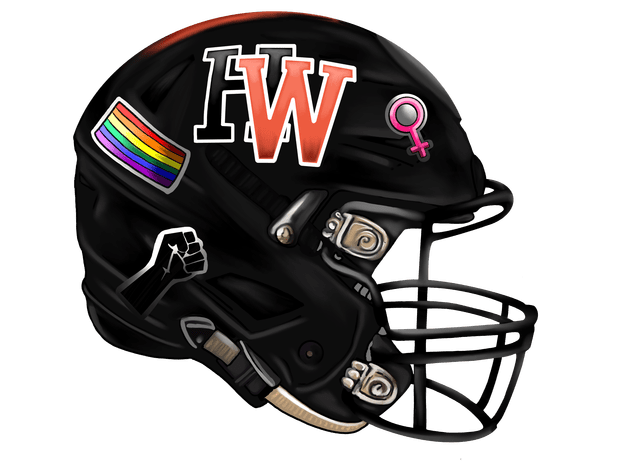Out of Bounds
August 26, 2020
As Jack Shane ’19 frantically ran into baseball practice, he felt the judgmental gazes of his teammates upon him. Late from dropping off his girlfriend, he rushed to apologize, only to be met with taunts from his friends
“That’s gay,” they said.
For Shane, these words represented the normalization of homophobic slurs and the negative connotations associated with the word ‘gay’ that he had witnessed in his years as an athlete.People always joked that I was gay because most of my friends were girls,” Shane said. “I had to be gay
because in their minds you have to be friends with guys and do ‘manly things’ to be a man.”
Shane is not the only student to express his frustrations with the toxic masculinity present in the school’s male athletic programs. According to The
New York Times, toxic masculinity includes the promotion of hyper-masculinity and repressed emotion.
Alumni takes to social media to address alleged homophobic behavior
Sarah Reiff ’20 recently sparked dialogue by referencing a football team group chat called ‘Gay Group chat’ in an Instagram story posted
Aug. 10. Reiff alleged several homophobic statements had been made in the
group chat. Since then, screenshots of Instagram comments in which members of the football team used the word ‘gay’ in an insulting manner have also been brought to light.
Head of Athletics Terry Barnum said the administration is
currently investigating the
group chat, which is not officially affiliated with the school.
Football player Albert* ’21, who identifies as bisexual, said the group chat was not a homophobic forum, despite its misleading name.
“[It was named that because] there was a meme that happened last year where, before games for good luck, we would hit on each other and compliment each other,” Albert said. “The name should never have been that, and that is a mistake all of us are willing to own up to.”
Current students share contrasting experiences to alumni on sports teams
Furthermore, Albert said the football team has created an L.G.B.T.Q. friendly environment.
“I think there has always been an understanding within the football team that homophobia isn’t right,” Albert said. “[Have I heard] the ‘f’ slur? Never. ‘Gay’ has been used a few times, but every time that it was used either I or someone else said ‘this isn’t right, this isn’t acceptable behavior.’”
Unlike Albert, former football player Loyal Terry ’19 said that despite improvement through the years, aspects of homophobia were present during his time on the team.
“To be blunt, when I first arrived [on the team], that language occurred often, but by the time I left it was not as acceptable,” Terry said. “Some people would still use that type of language, and I am confident that in certain groups that language persisted.”
Students react to news of existence of group chat, opening up larger conversation about homophobia
To queer student Audrey Perkins ’23, the group chat is representative of a larger culture of homophobia within male athletics.
“I’m sad to say that I wasn’t actually that surprised by the football group chat and what has been [allegedly] said in it,” Perkins said. “ I don’t think many of them realize how common L.G.B.T. people really are, or that they most likely have L.G.B.T. friends of their own. Being surrounded by homophobia all the time, especially within your friend group, could lead a closeted person to feel extremely alone
and probably push them further into the closet.”
According to the American Psychiatric Association, L.G.B.T.Q. individuals are 2.5 times more likely to experience substance abuse, anxiety or depression compared to their heterosexual peers. These numbers largely correlate
to the discrimination, isolation
and homophobia that L.G.B.T.Q. individuals experience throughout their lifetime, the LGBT Foundation said on their website
.
Like Perkins, queer male athlete Steve* said his coming out experience was delayed by the casual, normalized homophobia he experienced in locker room and team environments.
“Not everybody comes from the same places and a lot of people can’t understand each other’s points of view on the team,” Steve said. “ I definitely had some friends, two friends, that I was kind of really scared of losing, so I just didn’t wanna say anything because I was afraid they would just not talk to me anymore.”
Other displays of toxic masculinity persevere on teams
In boys athletic programs, Shane said toxic masculinity is perpetuated beyond homophobia with misogynistic comments and an overall sexist attitude. Shane said he recalled an instance where girls were ranked for their appearance above and “below the neck,” as well as an incident where a teammate instructed others to call his ex-girlfriend a whale.
“It happened so much that it almost became this big mush of things where you can’t remember the exact times you heard each one,” Shane said. “It just feels like everything was involved some way in misogyny and objectification.”
Terry said he felt that this misogyny was not exclusive to male athletics but was more commonly found
there.
“This occurred in almost every sphere of life at Harvard-Westlake,” Terry said. “Boys and girls would do this, and while it is more destructive in many instances with boys objectifying women, everyone did it. I at least knew plenty of people who did it in their ‘safe’ spaces.”
However, according to Shane, the most prominent aspect of toxic masculinity in male athletics was the suppression of male emotion.
“There’s this famous quote from Tom Hanks that says there’s no crying in baseball,” Shane said. “I was always taught that from a young age, to not show that kind of emotion. When you suppress your emotions for so long and you don’t even talk about them or feel them, you are bound to eventually become aggressive with them.”
In the sports program, Shane said efficiency and athletic achievements were prioritized over athletes’ mental health, and students were taught and encouraged to put the team’s success before themselves.
“It got to the point where you can’t really admit that you couldn’t beat something, whether it be school or stress or sickness,” Shane said. “You had to constantly be the one winning.”
Since his departure from the school, Shane said he has been able to prioritize his mental health in a way he never knew possible.
“I didn’t even know therapy existed until I got to college,” Shane said. “A lot of our view on therapy in high school was that therapy means something is wrong with you and you have an issue, not that therapy is just another tool in the bucket to help you fight whatever you are going through.”
Students and faculty call for empathy and change
Barnum said he believes student-athletes are reluctant to come forward not only because of the prevalence of hyper-masculinity but also because of the possible social consequences.
“I think that there might be some students that fear going forward because if you go to an adult, an adult is going to do something about it, and that might come at a social cost for the student,” Barnum said.
Perkins said that because toxic masculinity is so deeply ingrained within society, she feels that students have the ultimate ability to dismantle hyper-masculine standards by calling out their peers and having difficult conversations.
“I know some people think that our school can fix these issues, but I don’t think that it can, at least not with the current approach that it has,” Perkins said. “Homophobia and heteronormativity are too ingrained in our society as a whole for a claim of no tolerance and a stand during [International Day Against Homophobia, Biphobia and Transphobia] to really reach these people.”
Barnum said the school is committed to promoting tolerance and acceptance to players, coaches and other figures within the athletics community
.
“We are working with adolescents, and teenagers at times make mistakes,” Barnum said. “So our job is,
when they do make mistakes or when they do need to be educated in areas of respecting one another [and] understanding and respecting our diversity, whether it be racial, religiousor sexual orientation, that they are responsible.”
*names have been changed































